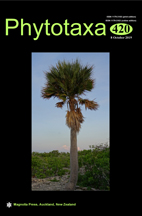Abstract
The genus Machilus Nees von Esenbeck (1831: 70) comprises c. 100 species distributed in tropical and subtropical S and SE Asia (Wei & van der Werff 2008). Kostermans (1952: 116) transferred Machilus to Persea Miller (1754: without pagination), but recent molecular evidence supports that Machilus should be treated as a distinct genus (Rohwer et al. 2009, Li et al. 2011). The type species Machilus odoratissima Nees von Esenbeck (1831: 70) was described with two unnamed varieties α and β based on the collections no. 2607A–F of Wallich’s Catalogue. For variety α, Nees von Esenbeck stated ‘paniculis floribusque pubescentibus, baccis globosis’ and cited ‘n. 2607 A ex parte, C, D, E.’ For variety β, he stated ‘paniculis floribusque glabriusculis aut sparsim puberulis, baccis ovatis vel (immaturis) oblongis’ and cited ‘n. 2607 A ex parte, B, F’. Hooker (1890: 859–860) was the first person to clarify Nees’s original material. He noted that the collection no. 2607A of Wallich’s catalogue from Nepal was in bud only, and the panicles as well as the buds were silky pubescent. In his opinion, it was possibly a large leaved form of M. bombycina King ex Hooker (1890: 861). In fact, the collection no. 2607A consists of several specimens deposited in different herbaria, bearing buds, flowers and fruits. The collections with silky pubescent buds (BM000888163, E00393305, E00393306, GZU000254236, K000821638, K000821637, K001116551, L0036904, L0036905, MEL2389976), pubescent flowers (GZU000254234) and globose fruits (GZU000254237) are of M. duthiei King ex Hook.f. (1890: 861) and the specimens with glabrous inflorescences (CAL0000073560, E00680973, K000228477, NY00355177, NY00355178) and oblong fruits (CAL0000073560, GZU000254235) are of M. odoratissima. Some fruits of M. odoratissima were wrongly placed in a packet attached to a specimen of M. duthiei bearing barcode no. GZU000254236. These fruits most likely have been taken from the specimen bearing barcode no. GZU000254235, which is of M. odoratissima. The collection no. 2607B from ‘Chercoolie’ in the ‘Deyra Dhoon’ (Dehra Dun) has a perfectly glabrous panicle, old flowers and oblong fruit. Hooker believed that this was what Wallich intended for M. odoratissima. He also stated that the collections from Rungpore and Patgong, no. 2607C, with globose small fruit, and perhaps (indicated by a question mark) the one from Goalpara, no. 2607D, were the cultivated M. bombycina. Hooker mentioned that the collection no. 2607E from Silhet, with a silky perianth and long glaucous leaves, was probably M. kurzii King ex Hooker (1890: 860) and the collection no. 2607F, supposedly from Singapore, was ‘unquestionably the same as B’, but the locality was almost certainly erroneous.

